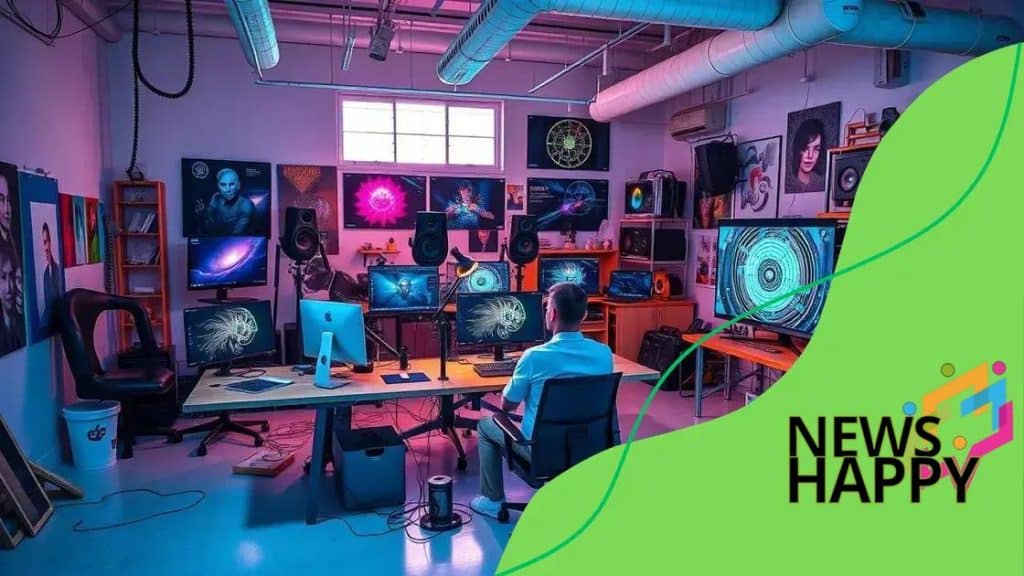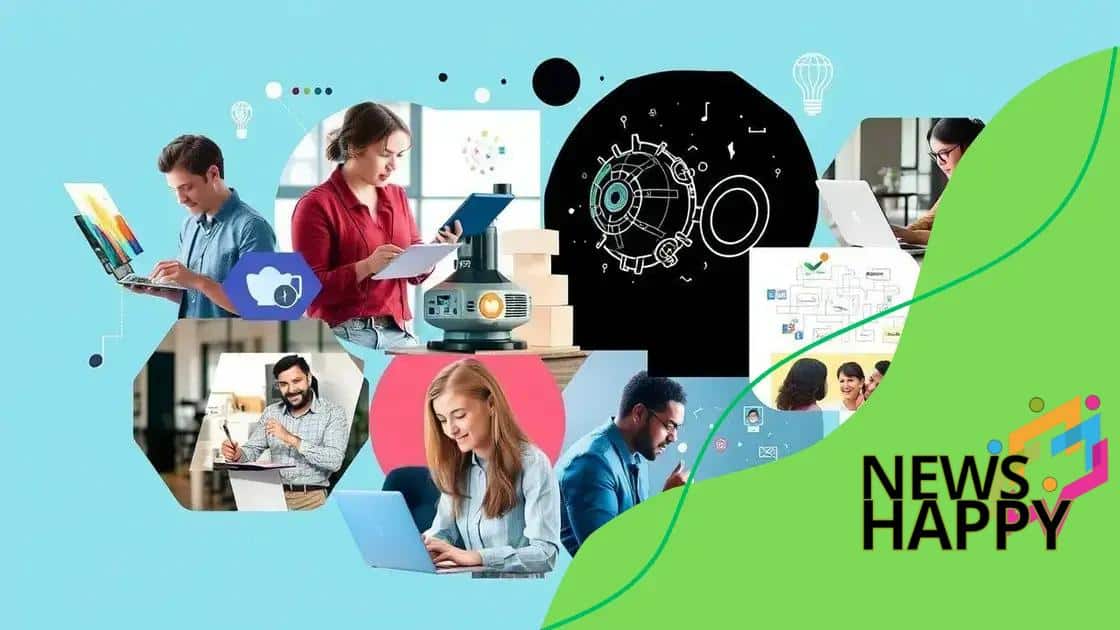The role of AI in transforming the creative industries

Anúncios
The role of AI in transforming the creative industries involves enhancing creativity, personalizing content, and streamlining production processes, enabling artists to innovate and collaborate more effectively.
The role of AI in transforming the creative industries is more significant than ever. Ever wondered how technology influences artists and creators? Let’s dive in and explore these changes together.
Anúncios
How AI is reshaping artistic creation
AI is revolutionizing the way art is created, pushing boundaries and opening up new possibilities for artists. From generating art to assisting in creative processes, AI tools are changing the landscape of artistic creation.
AI in art generation
Several innovative systems and algorithms allow creators to generate artwork in various styles. Artists now have the ability to harness AI to produce unique pieces, blending their vision with the capabilities of technology.
- Generative art creation
- Algorithmic design and patterns
- AI-generated illustrations and graphics
These tools empower artists to explore new areas of creativity while maximizing efficiency in their work.
Anúncios
Collaborative tools for artists
Many artists are utilizing AI as a collaborator rather than a replacement. By integrating AI tools into their workflow, they can enhance their personal style and expand their creative reach. This collaboration leads to exciting outcomes where human emotion meets computational precision.
The role of AI extends beyond just visual arts; it includes music composition, writing, and much more. AI can analyze vast datasets to understand trends and preferences, helping artists tailor their creations to audience tastes.
- AI in music creation
- Using AI for writing assistance
- Exploring AI in dance choreography
As artists embrace these technological advancements, the lines between human creativity and artificial intelligence continue to blur, leading to a rich exploration of the artistic realm.
The impact of AI on content production
The impact of AI on content production is profoundly reshaping how creators develop and distribute their work. With advanced algorithms, AI is now enabling more efficient and innovative content creation across various mediums.
Enhancements in writing and editing
AI tools assist writers in generating ideas and refining their work. From suggesting topics to grammar corrections, these tools play vital roles in enhancing the writing process. Many creatives leverage AI for:
- Content suggestions based on trends
- Grammar and style improvement
- Automated proofreading
This assistance allows writers to focus on creativity while ensuring quality and coherence in their work.
The role of AI in visual content creation
For visual content, AI has proven invaluable. Designers and marketers use AI to create engaging graphics and videos that attract audiences. With machine learning algorithms, AI can analyze user preferences and suggest designs that resonate well.
AI’s capabilities extend to:
- Video editing and enhancement
- Personalized graphic design
- Content optimization for social media
As AI continues to evolve, it becomes a powerful ally, enabling creators to produce high-quality content rapidly while maintaining their unique style.
The integration of AI in content production not only streamlines workflows but also fosters innovation. By automating repetitive tasks, creators can allocate more time to brainstorming and experimenting, leading to richer narratives and visual storytelling.
AI tools enhancing creativity across sectors

AI tools enhancing creativity across sectors are fostering innovation in various fields, from art and design to marketing and education. These technologies help professionals tap into their creative potential by offering new perspectives and capabilities.
AI in design and art
In the design world, AI-powered tools assist artists and designers in generating unique concepts. By analyzing vast data sets, AI can suggest patterns and styles that might inspire new creations. Artists are embracing tools like:
- AI-driven logo and branding design
- Style transfer applications for art
- Color palette generators
These tools allow creatives to experiment without traditional limitations, opening doors to impressive artistic outcomes.
Marketing innovations with AI
AI also plays a crucial role in marketing. Businesses utilize AI to generate content that captivates their audience. With tools designed for analyzing market trends, companies can tailor their strategies effectively. AI aids in:
- Automating social media posts
- Creating personalized email marketing
- Analyzing customer preferences
This use of AI helps marketers optimize their campaigns and foster a deeper connection with their customers.
AI’s influence stretches into education, where it assists teachers in providing personalized learning experiences. With AI, educators can adapt their teaching methods to fit individual student needs, ensuring everyone can grasp complex concepts effectively.
The integration of AI tools across sectors not only enhances creativity but also encourages collaboration among different fields, leading to groundbreaking innovations that might not have been possible otherwise.
Challenges in integrating AI in the arts
The challenges in integrating AI in the arts are becoming more apparent as artists embrace new technologies. While AI offers exciting opportunities, it also presents obstacles that need to be navigated.
Understanding the technology
Many artists may not fully grasp how AI works, which can limit their ability to incorporate it into their creative processes. The complexity of AI algorithms can be daunting, and this knowledge gap creates a barrier. Artists often face:
- Difficulty in learning new software
- High costs of AI tools
- Limited access to training resources
This lack of understanding can hinder creativity, as artists might be unsure how to effectively use AI.
Ethical concerns in AI-generated art
Ethics poses another significant challenge. When artists use AI to create, questions arise about ownership and originality. Who owns an artwork produced by AI? Is it the artist or the creator of the algorithm? Another concern is the potential for AI to produce art that could misrepresent cultures or propagate stereotypes.
Some key ethical considerations include:
- Authenticity of AI-generated pieces
- Impact on traditional art forms
- Fair compensation for artists
These issues have led to debates in the community that artists and technologists need to address to foster collaboration.
Despite these challenges, the integration of AI continues to grow. By facing these obstacles head-on, artists can find ways to incorporate AI into their work while maintaining their distinct voices, leading to innovative and thought-provoking creations.
Future trends of AI in creative industries
The future trends of AI in creative industries are shaping the way artists, designers, and creators approach their work. As technology advances, we can expect AI to play an even bigger role in various creative processes.
Greater personalization in content creation
One significant trend is the rise of personalization. AI can analyze data to understand audience preferences, allowing creators to craft more tailored content. This personalization enhances user experience, making it more engaging. In the future, we may see:
- Customized marketing campaigns based on AI insights
- Interactive storytelling tailored to user choices
- Designs that adapt in real-time to audience reactions
This level of customization is geared towards capturing attention and driving deeper connections with audiences.
Collaborative AI tools
Another important trend is the development of collaborative AI tools that aid human creativity rather than replace it. These tools will empower artists by acting as partners in the creative process. For instance, we could see:
- AI systems that suggest design elements as artists work
- Smart editing tools in video production
- AI assistants that help writers brainstorm ideas
Such collaborations can spark innovation while allowing artists to maintain their unique voices and styles.
Additionally, AI is expected to play a key role in generating content quickly and efficiently. This will allow artists to focus more on the creative aspects rather than repetitive tasks. Automated processes in content production can lead to a significant increase in productivity, which is vital in today’s fast-paced creative environment.
The ongoing evolution of AI in creative industries signals a bright future, where technology enhances human creativity and helps artists push boundaries further than ever before.
In conclusion, the integration of AI in creative industries is ushering in a new era of innovation and expression. As technology continues to evolve, AI will provide tools that enhance creativity, personalization, and collaboration. The future holds exciting possibilities, allowing artists and creators to push boundaries and redefine their work. Embracing these advancements can lead to a richer creative landscape, where technology and human expression thrive together.
FAQ – Frequently Asked Questions about AI in Creative Industries
How is AI transforming creative processes in the arts?
AI is providing tools that enhance creativity and streamline workflows, allowing artists to experiment with new techniques and ideas.
What are some ethical concerns related to AI in art?
Ethical concerns include questions of authorship, originality, and the potential misrepresentation of cultures through AI-created works.
Can AI create art without human input?
Yes, AI can generate art autonomously, but many artists prefer using AI as a collaborative tool to enhance their creativity.
What trends can we expect for AI in creative industries in the future?
Future trends include increased personalization of content, enhanced collaboration between humans and AI, and faster content production, leading to innovative outcomes.





